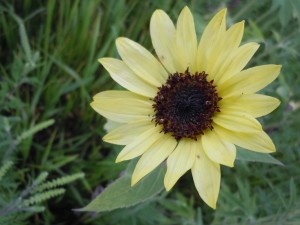
Sunflowers and nearly everything that grows is lagging behind this spring in Iowa. (photo/Cindy Hadish)
It was nice to see the sun today, after what has been an unusually wet and cool spring.
That wet weather is keeping farmers out of their fields, as the following reports from Iowa Secretary of Agriculture Bill Northey and the Iowa Crops and Weather report released by the USDA National Agricultural Statistical Service show:
“Planting continues to lag behind as the continuing rains have prevented fields from drying and limited farmers’ ability to get in the fields,” Northey said. “Several days of warm dry weather are needed to allow fields to dry and to help those that have been planted grow.”
The weekly report is also available on the Iowa Department of Agriculture and Land Stewardship’s website at www.IowaAgriculture.gov<http://www.IowaAgriculture.gov> or on USDA’s site at www.nass.usda.gov/ia<http://www.nass.usda.gov/ia>. The report summary follows here:
CROP REPORT
Rainfall continued to limit fieldwork for Iowa farmers during the week ending June 9, 2013, according to the USDA, National Agricultural Statistics Service. Fields already wet from the previous week, did not dry enough between rain events to allow significant planting progress to be made. Farmers commented warmth and sun would benefit the growing corn and soybean crops.
Statewide there was an average of 1.7 days suitable for fieldwork during the week. East Central Iowa, with 2.5, had the most days suitable for fieldwork during the week. North Central Iowa, with 0.9, had the least days suitable. Topsoil moisture levels rated 0 percent very short, 0 percent short, 42 percent adequate and 58 percent surplus. Subsoil moisture levels rated 0 percent very short, 2 percent short, 60 percent adequate and 38 percent surplus. The surplus subsoil rating is the highest since August 2010.
Ninety-two percent of Iowa’s corn crop was in the ground, 4 percentage points higher than last week, and still lagging behind the five-year average of 99 percent. Eighty-one percent of the corn crop has emerged, behind the normal 96 percent. Corn condition was reported at 3 percent very poor, 11 percent poor, 34 percent fair, 44 percent good and 8 percent excellent. Farmers have planted 60 percent of the soybean crop, an advancement of 16 percentage points from last week, but still much lower than the normal 95 percent. Soybean emergence was 39 percent complete; well behind both last year’s 93 percent, and the five-year average of 83 percent. Both the planting and emergence for soybeans were the latest since 1993. Sixteen percent of the oat crop was headed, and the crop condition rated 0 percent very poor, 5 percent poor, 25 percent fair, 58 percent good and 12 percent excellent.
The first cutting of alfalfa hay was 10 percent complete, well behind last year’s 96 percent. Many farmers were delaying cutting alfalfa until dry weather to avoid rain damage. The first hay condition rating of the year reflected 1 percent very poor, 3 percent poor, 28 percent fair, 53 percent good and 15 percent excellent. Pasture and range conditions rated 1 percent very poor, 6 percent poor, 25 percent fair, 45 percent good and 23 percent excellent.
IOWA PRELIMINARY WEATHER SUMMARY
By Harry Hillaker, State Climatologist, Iowa Department of Agriculture & Land Stewardship
Unseasonably cool weather prevailed throughout the past reporting week. Temperatures were below normal every day at all locations in the state with daytime highs mostly in the 60’s to low 70’s. Temperature extremes varied from a Monday (3rd) morning low of 37 degrees at Elkader to a Saturday (8th) afternoon high of 79 degrees at Keokuk. Temperatures for the week as a whole averaged 6.1 degrees below normal. The temperature has yet to reach 80 degrees anywhere in Iowa thus far in June while Elkader’s 37 degree reading was the lowest recorded in Iowa for so late in the season since 1998. Rainfall amounts were mostly on the light side of normal over southeastern portions of the state and above normal over the northwest. Welcome dry weather prevailed in most areas on Sunday (2nd), Monday (3rd), Thursday (6th) and Friday (7th) Rain was widespread on Tuesday (4th) with locally heavy rain scattered over the north and west. Light to moderate rain fell over eastern Iowa on Wednesday (5th). Finally, rain was widespread over the west on Saturday (8th) and slowly spread to eastern areas on Sunday (9th). Weekly totals varied from only 0.05 inches at Burlington to 3.10 inches at Underwood (Pottawattamie Co.) and 3.11 inches at Rock Valley (Sioux Co.). The statewide average precipitation was 1.11 inches or just under the weekly normal of 1.18 inches.

No Comments Yet